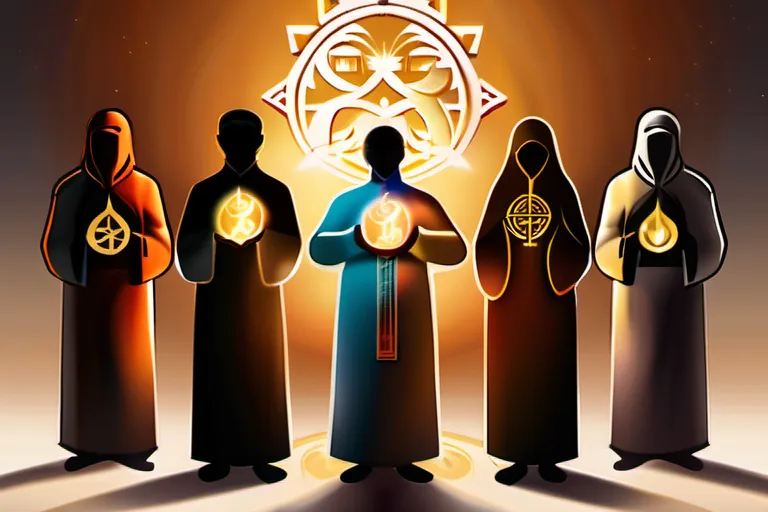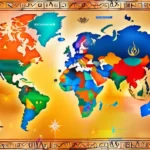Delve into the fundamental tenets of Christianity, Islam, Hinduism, Buddhism, Judaism, and more.
In this article, we will embark on a journey to explore the core beliefs that define some of the world’s most influential religions. From the monotheistic faiths of Christianity, Islam, and Judaism, to the polytheistic traditions of Hinduism and Buddhism, we will uncover the unique doctrines, practices, and values that shape these belief systems.
The Monotheistic Faiths: Christianity, Islam, and Judaism
Imagine walking through a vast landscape where towering mountains represent the many beliefs and practices of religions across the globe. Among these, three significant peaks stand out: Christianity, Islam, and Judaism. These monotheistic faiths share a common belief in one all-powerful God, yet their paths to understanding Him diverge into unique traditions and interpretations.
In Christianity, God is seen as a triune being—Father, Son, and Holy Spirit—revealed through the life of Jesus Christ. Christians often ask: ‘Who is Jesus?’ For many, He is not just a good teacher but the savior who offered forgiveness for their sins. This belief forms the core of Christian faith, making it central to their moral values and practices.
Islam, on the other hand, presents Allah as the one true God. Muslims believe that Islam is the final and complete revelation from Him, meant to correct any deviations in earlier messages. The phrase ‘There is no god but Allah’ echoes through the faith, emphasizing the absolute oneness of God. For Muslims, the journey towards salvation involves a balance of prayer (Salat), fasting (Sawm), charity (Zakat), pilgrimage (Hajj), and testimony to the unity of God.
Judaism also reveres the one God but focuses more on His covenant with the Jewish people. The teachings in the Torah guide their daily lives, emphasizing justice, morality, and the commandments. Questions like ‘What does it mean to be a faithful Jew?’ resonate deeply within this faith, as Jews seek to maintain their identity while integrating into broader societies.
These three monotheistic religions are more than just beliefs; they are complex living traditions that shape the lives of billions. They offer paths towards understanding and connecting with a higher power, each with its unique approach and insights. As we explore further, you’ll see how these faiths intertwine and differ, painting a rich tapestry of human spirituality.
The Polytheistic Traditions: Hinduism and Buddhism
The Polytheistic Traditions: Hinduism and Buddhism
Imagine stepping into the colorful tapestry of ancient traditions, where countless deities weave through the fabric of daily life. In Hinduism, we encounter a pantheon so vast it feels like an endless universe of gods and goddesses, each with their unique stories and attributes. From the mighty Brahma, creator of the cosmos, to Saraswati, the goddess of knowledge, every deity serves a purpose in this intricate web of beliefs. How do these gods guide human lives? What roles do they play in shaping destiny?
Hinduism’s teachings on karma and reincarnation offer a profound perspective on life’s journey. Like seeds that are sown into fertile soil, our actions (karma) determine the next chapter in our existence. This cycle of birth, death, and rebirth is seen as both an obstacle to be overcome and a path towards enlightenment. But what exactly does it mean to attain enlightenment? Is it like climbing the highest peak in search of a breathtaking view, or more akin to finding inner peace amidst life’s storms?
In Buddhism, while there is no creator god, the concept of the divine is embodied by enlightened beings or Buddhas. These are individuals who have transcended suffering and serve as guides on the path to enlightenment. The teachings revolve around the Four Noble Truths and the Eightfold Path, guiding practitioners through a journey towards Nirvana—freedom from the cycle of rebirth. But can one truly imagine a world without desire or pain? How does embracing such an idea change one’s perception of reality?
Both religions share themes of interconnectedness and the pursuit of inner peace, yet they approach these concepts with distinct philosophies and practices. Whether through devotion to deities in Hinduism or meditation in Buddhism, both paths lead towards a deeper understanding of self and the world around us.
The Role of Scripture in Each Religion
When exploring the core beliefs of top religions, one cannot overlook the pivotal role that scripture plays. These sacred texts are more than just collections of words—they are the lifelines that connect followers to their faiths. Let’s delve into the heart of these scriptures in Christianity, Islam, Hinduism, Buddhism, and Judaism.
In Christianity, the Bible serves as the central authority, encompassing both the Old and New Testaments. It is a grand narrative that traces the history of salvation from the creation of the world to the life, death, and resurrection of Jesus Christ. Could you imagine a journey where every event, every word, holds profound significance? The Bible not only guides ethical behavior but also offers hope and comfort through its stories and teachings.
Islam places great emphasis on the Quran, believed to be the final revelation of God. Comprising revelations given to the Prophet Muhammad, it is considered infallible and inimitable. How would you feel if your beliefs were rooted in a text that promised divine guidance for all aspects of life? The Quran provides Muslims with moral codes, prayers, and historical accounts, shaping their daily lives and interactions.
The Vedas form the spiritual foundation of Hinduism, comprising four collections of sacred texts. These hymns, rituals, and philosophical discussions offer insights into cosmic truths and the nature of reality. Can you imagine a library where each book holds mystical power to enlighten the mind and soul? The Vedas are not just read; they are chanted and studied with reverence, guiding Hindus towards spiritual liberation.
Buddhism’s sacred texts, including the Pali Canon and Mahayana Sutras, offer teachings that focus on achieving enlightenment through the path of the Middle Way. How does one navigate a path that seeks to balance extremes in life? These scriptures provide practical guidance and wisdom for living a virtuous life, fostering compassion and understanding.
In Judaism, the Torah stands as the central text, containing the first five books of the Hebrew Bible. It outlines the covenant between God and Israel, setting forth laws, commandments, and narratives that define Jewish identity. Could you fathom a religious tradition where the core beliefs are written in the same documents used daily for prayers and study? The Torah is more than history; it is a living guide to ethical conduct and divine will.
Each of these scriptures serves as a compass, directing believers through life’s complexities. Whether it’s the Bible’s promise of salvation, the Quran’s commandments, the Vedas’ philosophical musings, the Buddhist texts’ path to enlightenment, or the Torah’s laws and covenants, these sacred writings provide direction and comfort in an often chaotic world.
Rituals, Practices, and Symbols
Rituals, practices, and symbols are like the vibrant threads that weave together the tapestry of each religion. In Christianity, for instance, baptism symbolizes the washing away of sins through water. It’s a metaphorical cleanse, much like starting anew with a fresh page in a journal. Communion, or the Eucharist, is another ritual where believers share bread and wine as symbols of Christ’s body and blood, a profound act that connects them spiritually to their faith and community.
In Islam, Salat, or prayer five times daily, is a way for Muslims to communicate with God. It’s akin to sending out a daily message of devotion and gratitude, much like the constant hum of bees in a hive, always active yet unnoticed until you stop and listen.
Hinduism, with its rich symbolism, features yoga as both a physical practice and spiritual journey. It’s more than just stretching; it’s about aligning your body, mind, and spirit, like finding the perfect balance on a tightrope. Meditation, or dhyana, is another profound practice that allows practitioners to transcend the material world, much like peering through a telescope to see beyond the stars.
Buddhism introduces the concept of reincarnation and the path towards enlightenment, often symbolized by the lotus flower. Just as the lotus rises from murky waters unscathed, so too can one achieve purity and clarity through spiritual practice. Practices like chanting and meditation are essential tools in this journey, guiding one away from suffering and towards peace.
Judaism, with its rich history, has rituals such as the Sabbath, a day of rest and reflection, emphasizing the importance of community and family. It’s like setting aside time to recharge your batteries, much needed in the fast-paced world we live in today.
Each religion’s unique rituals, practices, and symbols are not just cultural artifacts but profound expressions of spiritual experience. They remind us that, no matter the path, there is a common thread that binds us all—our quest for meaning, connection, and transcendence. Whether it’s the baptismal waters or the lotus flower, these rituals invite us to delve deeper into the rich, multifaceted world of spirituality.
The Impact of Each Religion on Society
How has Christianity shaped society? From the birth of the Christian movement in Jerusalem to its global spread, Christianity has been intertwined with political and social structures. In Europe during the Middle Ages, the Church wielded immense power, often dictating laws and governance. But even today, discussions about abortion, LGBTQ+ rights, and religious freedom are heavily influenced by Christian doctrines. Think about it: if the Beatitudes—the words of Jesus in the Sermon on the Mount—are taken to heart, how might society look different?
In Islam, the impact is just as profound. The concept of Shariah law has influenced legal systems in many Muslim-majority countries, impacting everything from criminal justice to family laws. The call to prayer reverberates through cities and towns, uniting Muslims daily under a shared spiritual experience. Can you imagine the world without the influence of Islam’s emphasis on charity, or its impact on education and scholarship during the Islamic Golden Age?
Hinduism too has left an indelible mark. The caste system, while controversial today, shaped social structures for centuries. The teachings of Karma and Moksha continue to guide not just individuals but also broader societal values around ethics and morality. How would our understanding of justice and equality be different if we considered the concept of reincarnation more seriously?
Buddhism has its own unique impact, particularly in East Asia where it blended with local traditions, leading to practices like Zen Buddhism and Vajrayana. The teachings of Anatta (non-self) challenge our very sense of identity, while the practice of Metta (loving-kindness) promotes social harmony and compassion. In a world often divided by conflict, could these principles offer new ways to approach human relations?
Judaism, with its emphasis on covenant and moral law, has shaped not only religious but also political movements. The idea of a chosen people has influenced both the development of Israel as a state and discussions about identity and sovereignty among Jews worldwide. How might our understanding of global citizenship be different if we considered the Jewish concept of Tikkun Olam—repairing the world?
The impact of these religions is multifaceted, shaping not just spiritual but also social, political, and cultural landscapes. From the rituals that bind communities to the ethical teachings that guide behavior, each religion offers a unique lens through which we can understand the world. As you explore further, consider how these beliefs have evolved over time and continue to influence modern society.
Contemporary Challenges and Debates
As we delve into contemporary challenges and debates, it becomes evident that each religion faces unique interpretive and reformative pressures. In Christianity, one might ask: How can traditional teachings be reconciled with modern ethical standards? The Church has long grappled with issues like LGBTQ+ rights and environmental stewardship, with many seeking a more inclusive interpretation while others adhere strictly to orthodox doctrines.
Turning to Islam, the question of reform becomes even more complex. Can Islam adapt to secular states without losing its religious and cultural identity? This debate often centers around issues such as women’s rights, freedom of expression, and the role of Sharia law in governance. Some argue for a return to early Islamic principles, while others advocate for modern interpretations that align with contemporary values.
Hinduism, with its vast array of sects and philosophies, faces challenges related to cultural preservation versus global influence. The rise of Hindutva ideologies has sparked debates about the nature of Hindu identity in a multicultural world. Additionally, there are ongoing discussions about the role of caste in contemporary society and how traditional practices can coexist with modern human rights standards.
In Buddhism, the debate revolves around the adaptation of ancient teachings to secular contexts. Can Buddhist principles guide ethical behavior in a capitalist economy? The mindfulness movement has popularized many Buddhist concepts but raises questions about authenticity and commodification. Moreover, as Buddhism spreads globally, there is an ongoing effort to maintain its spiritual integrity while making it accessible to diverse cultures.
Judaism’s challenge lies in balancing tradition with modernity without losing its rich cultural heritage. Reform, Conservative, and Orthodox branches of Judaism each offer distinct perspectives on adaptation. Questions about Zionism, the role of women in religious practice, and how traditional texts should be interpreted in a post-Holocaust world continue to shape Jewish thought.
Each religion’s response to these challenges is deeply intertwined with its historical context and the cultural milieu it inhabits. These debates reflect not just internal theological struggles but also external pressures from globalization, technological change, and social evolution. As we navigate this complex landscape, understanding the core beliefs of each religion becomes essential for grasping their current relevance and future directions.
Conclusion
 By understanding the core beliefs of these religions, we gain a deeper appreciation for the rich tapestry of human spirituality. We also learn about the commonalities and differences between these faiths, fostering greater empathy and respect among believers and non-believers alike.
By understanding the core beliefs of these religions, we gain a deeper appreciation for the rich tapestry of human spirituality. We also learn about the commonalities and differences between these faiths, fostering greater empathy and respect among believers and non-believers alike.











